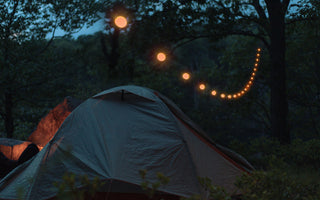
If you’ve ever stood in the lighting section of an outdoor shop and wondered what “500 lumens” really means, it turns out you aren’t alone. In this article, we break down what a lumen is, how to lumens apply to your camping experience, and what else to consider when selecting your camping lantern.
What is a lumen?
Simply, a lumen is a unit of measurement for light output. The more lumens, the brighter the light.
Here are common lighting examples and their approximate lumen count:
- Candle = ~10 lumens
- Flashlight = ~200 lumens
- Ceiling lights = ~1,000 lumens
At BioLite, we often integrate the number of lumens into the names of our rechargeable camping lanterns. For example, the AlpenGlow 500 has 500 lumens.

How bright of a light do you need?
This article is focused specifically on LED lanterns, not flashlights and headlamps which provide directional lighting. While these options are great for tasks that require a focused beam, camping lanterns are the go-to for illuminating larger areas for your camping crew.
Ways to think about the lumens you need around your campsite:
Inside your tent (75–150 lumens):
Small spaces like tents require very little light. Our eyes do a great job of adjusting to the dark in the evening, so lanterns in this lumen range are usually enough to read or play cards without blinding anyone.
On the table (200–500 lumens):
Camp tables are where much of the action takes place at the site. LED lanterns offering 250-500 lumens are perfect for cooking and gathering.
Site-wide illumination (500–1000+ lumens):
When it comes to lighting your entire site, it’s best to match your lanterns to your group size and the size of the site. Often, having 2-3 lanterns at 500 lumens is more than enough even for a large site.
String Lights: Solar powered string lights are another great way to light a larger area.

Beyond Brightness: Other considerations when looking for a camping lantern
While brightness is the most obvious feature to consider when choosing an LED lantern, it’s certainly not the only aspect to keep in mind. A few other variables you may want to consider are:
Lighting modes
Does the lantern offer the option to dim (we highly recommend this) and do you want other color-changing modes to help set the ambiance or match the mood at the campsite.
Power source
Nowadays, all of our most regularly used devices are rechargeable. Your camping lantern should be too. Rechargeable camping lanterns save you money long term, are better for the planet, and don’t involve the hassle of searching for spare batteries. Go even further when you choose solar powered lighting.
Water/weather resistance
Unless you’re planning on epic water adventures, you likely don’t need a fully waterproof lantern. Still, having an IP rating that ensures your light doesn’t get damaged in that surprise storm is peace-of-mind when you head out. Luci Lanterns are fully waterproof, while AlpenGlow Lanterns are IPX4 for rain and other inclement weather.
Hanging/placement abilities
More times than not, you’ll want to move your lights throughout the night - from the table cooking, to the fire area, and finally to the tent. Some rechargeable camping lanterns give you more options than others.
Portability
Similar to hanging/placement abilities, keep in mind the style of camping you do. Car camping? You can get away with heavier gear. Backpacking long distances? You’ll want a lightweight LED lantern.

Conclusion: Now you’re a smart lantern shopper
You’re ready to awe friends on your next trip to the outdoor shop when they ask, “What is a lumen?” Whether you’re a backpacker pitching a quick tent or a family setting up a car camping party with friends, matching lumens and camping lantern features to your needs helps you get the most out of your gear - and your trip.
Shop BioLite’s rechargeable lanterns and lighting to find your perfect match >
Find this article useful? Do us a favor and share it with a friend 👇

